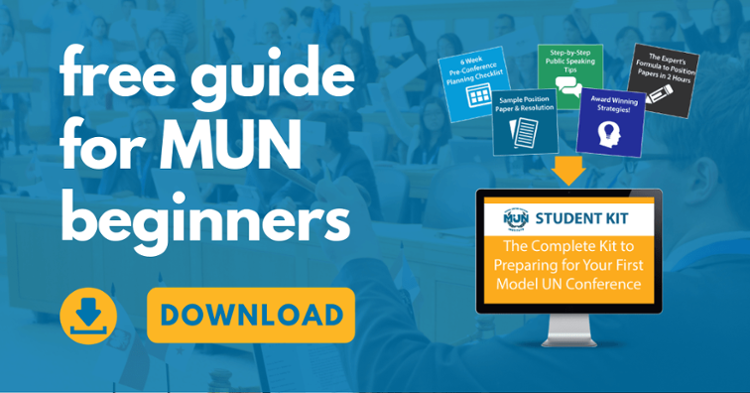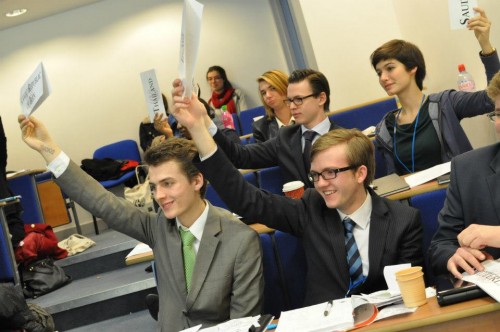The first time doing Model United Nations may seem confusing. Delegates may be using all sorts of terms that are unfamiliar to you and it may almost seem like they are speaking another language. Fortunately, surviving committee is pretty easy if you know what the most important and commonly used terms. Keep in mind that the actual United Nations does not use parliamentary procedure and that Model UN is decentralized with no formal governing body, so not every conference uses all of the terms below and some conferences may even call a particular action by a different name.
Here are the top 20 important terms to know in committee sorted by category below. And if you’re still unsure when you get to committee, don’t hesitate to raise a Point of Inquiry!
General
1. Chairs: The chairpersons are seated in the front with their gavel and facilitate the debate. They call on speakers, time speeches, and maintain the rules of procedure. If the conference gives awards, they will also evaluate your performance.
2. Decorum: order in committee. The chair may call decorum if delegates are loud or disrespectful, in order to ask for their attention during committee.
3. Motion: a specific action made by delegates to direct debate in a certain direction.
4. Speaker’s List: a list that contains the order of speakers in the committee. The specific way that the order is determined varies by conference. The Speaker’s List is the default format of debate and committee will proceed with speeches until a delegate makes a motion to change up the debate format.
5. Yield: this is when a speaker decides to give up the remaining time in his or her speech. Typically, the three types of yields are: 1) Yield to the Chair meaning you give up the rest of your time, 2) Yield to another delegate meaning you give up the rest of your time to another delegate, or 3) Yield to questions from other delegates or Yield to comments to your speech by other delegates. Questions are also sometimes called Points of Information.

Points
6. Point of Inquiry: used when a delegate has a question about something that is not clearly understood in committee. Use this to ask a question if you don’t understand a term or get what’s going on in committee!
7. Point of Personal Privilege: used when a delegate experiences personal discomfort that hinders their ability to participate in committee. Examples: temperature of room, distractions during committee, can’t hear another delegate, etc.
8. Point of Order (also called Point of Parliamentary Procedure): used when a delegate believes that there was a mistake made regarding the rules of procedure
Caucus
9. Moderated Caucus: A debate format that allows delegates to make short comments on a specific sub-issue. Typically, delegates who are interested in speaking will raise up their placards and the Chairs will call on delegates to speak one at a time. In order to move into a moderated caucus, the motion must include the overall speaking time, the time per speaker, and the sub-issue to be discussed. Example: Italy moves for a 5 minute moderated caucus with 30 second speaking time per delegate for the purpose of discussing solutions to women’s rights.
10. Unmoderated Caucus (also called Informal Caucus or Lobbying Sessions): a debate format in which delegates can leave their seats to go and talk to others freely and informally. This is usually when delegates find allies and work on draft resolutions. In order to move into an unmoderated caucus, the motion must include the overall caucus time and preferably the purpose of the unmoderated caucus. Example: Senegal moves for an unmoderated caucus for 10 minutes to complete draft resolutions.
11. Blocs: different groups that have similar ideas and opinions about the topics. In the real United Nations, there are regional blocs, but delegates can choose to build their own blocs in Model UN. These blocs will typically work together to create a draft resolution.
Resolutions
The goal of committee is to pass a resolution. Although you may not know how to write a resolution yet, it’s important to know the basic terms so you can keep up as they are presented.
12. Working paper: Working papers are just a list of ideas formed by the blocs. They may or may not be written in resolution format. The working paper needs to be approved by the chairs.
13. Draft Resolution: A document written in resolution format, approved by the chairs, and introduced to committee but not yet voted upon is called a draft resolution. Delegates will be spending most of their time writing and amending the draft resolutions. Once a draft resolution is passed by a committee, then it becomes a Resolution.
14. Sponsors: delegates who authored the draft resolution or actively contributed ideas. They support the draft resolution and want to see it get passed, so they should vote for it. All resolutions will require a minimum number of sponsors.
15. Signatories: delegates who wish the see the draft resolution debated but may or may not agree with all of the ideas. However, they think there is some merit to it and want to see it presented. Some resolutions will require a minimum number of signatories.
16. Pre-ambulatory clauses: statements in the first section of the draft resolution that describes the problems that the committee wants to solve as well as previous measures taken to combat the problem. Pre-ambulatory clauses are usually italicized or underlined by not numbered.
17. Operative clauses: statements in the second section of the draft resolution that outlines the specific solutions the sponsors wish to implement. Operative clauses are usually numbered and underlined.
18. Amendment: a change made to an operative clause of a draft resolution. Amendments can add, delete, or change an operative clause in a draft resolution. A Friendly Amendment is an amendment written and approved by all the sponsors to a draft resolution and is automatically included into the text. An Unfriendly Amendment is an amendment not approved by all the sponsors to their draft resolution and must be voted upon before it can be included into the text.
19. Merging: combining two or more draft resolutions to make a bigger or new draft resolution
20. Voting bloc: when delegates vote on the draft resolutions and amendments
Want to learn more about MUN basics? Check out the MUN Institute!



